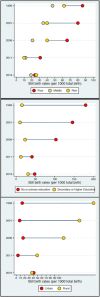The Association of Women's Empowerment with Stillbirths in Nepal
- PMID: 31784858
- PMCID: PMC7048701
- DOI: 10.1007/s10995-019-02827-z
The Association of Women's Empowerment with Stillbirths in Nepal
Abstract
Introduction: Globally, 2.6 million stillbirths occur each year. Empowering women can improve their overall reproductive health and help reduce stillbirths. Women empowerment has been defined as women's ability to make choices in economic decision-making, household and health care decision-making. In this paper, we aimed to evaluate if women's empowerment is associated with stillbirths.
Methods: Data from 2016 Nepal Demographic Health Surveys (NDHS) were analysed to evaluate the association between women's empowerment and stillbirths. Equiplots were generated to assess the distribution of stillbirths by wealth quintile, place of residence and level of maternal education using data from NHDS 1996, 2001, 2006, 2011 and 2016 data. For the association of women empowerment factors and stillbirths, univariate and multivariate analyses were conducted.
Results: A total of 88 stillbirths were reported during the survey. Univariate analysis showed age of mother, education of mother, age of husband, wealth index, head of household, decision on healthcare and decision on household purchases had significant association with stillbirths (p < 0.05). In multivariate analysis, only maternal age 35 years and above was significant (aOR 2.42; 1.22-4.80). Education of mother (aOR 1.48; 0.94-2.33), age of husband (aOR 1.54; 0.86-2.76), household head (aOR 1.51; 0.88-2.59), poor wealth index (aOR 1.62; 0.98-2.68), middle wealth index (aOR 1.37; 0.76-2.47), decision making for healthcare (aOR 1.36; 0.84-2.21) and household purchases (aOR 1.01; 0.61-1.66) had no any significant association with stillbirths.
Conclusions: There are various factors linked with stillbirths. It is important to track stillbirths to improve health outcomes of mothers and newborn. Further studies are necessary to analyse women empowerment factors to understand the linkages between empowerment and stillbirths.
Keywords: Nepal; Stillbirths; Women’s autonomy; Women’s empowerment.
Conflict of interest statement
There was no conflict of interest in the carrying out of the study or the production of this paper.
Figures
References
MeSH terms
LinkOut - more resources
Full Text Sources
Medical


